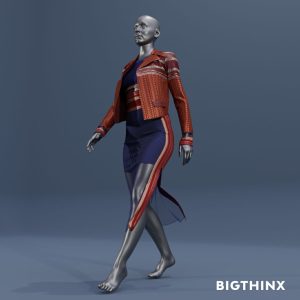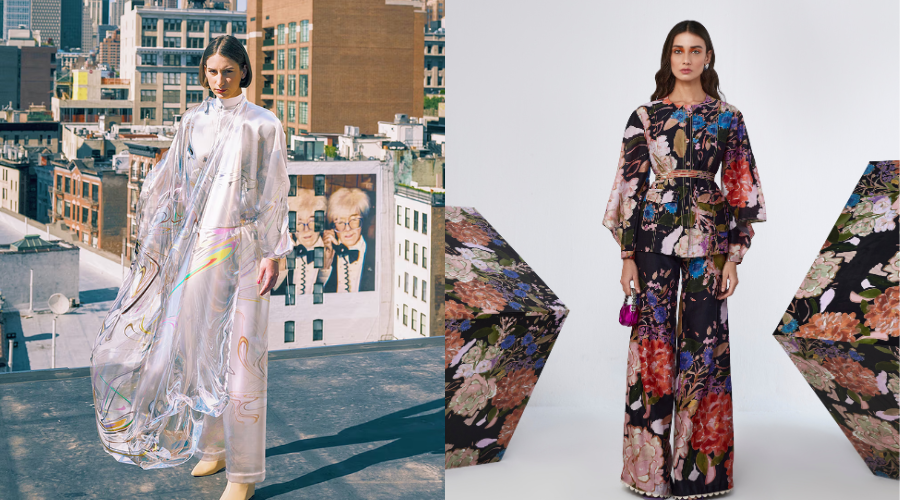A dialogue surrounding the genuine impact of sustainability in fashion continues to provoke discussion. Is it a substantial reduction in carbon footprint or merely a facade for greenwashing? As the fashion industry faces increased scrutiny over its environmental impact, designers are turning to technology such as 3D printing, virtual sampling, AI, and augmented reality to reduce their ecological footprint. While these innovations offer benefits, questions still persist. Are traditional methods being replaced by technological innovations? Do these innovations effectively address the climate crisis?
Most fashion designers have expressed their curiosity and openness towards technology. However, many of them also showed a preference for traditional analogue methods that have worked for them in the past. Designer Ridhi Mehra believes that the answer lies somewhere in between. “Old-school methods often involve resource-intensive processes contributing to a higher carbon footprint. In contrast, AI trial rooms and 3D design reduce waste, energy, and material consumption. Embracing digital innovations does align with modern environmental consciousness in the fashion industry. Yet a majority of our audience still prefers an in-person experience, especially when it comes to trying on pieces,” she says.

Effecting Sustainable Change
In 2021, Lakme Fashion Week in India launched a digital couture campaign in partnership with NEXA. Six renowned Indian designers, namely Abraham & Thakore, Payal Singhal, Amit Aggarwal, Huemn, Kanika Goyal, and Ridhi Mehra, participated in the campaign. They each developed a sketch of a garment that was then turned into a 3D virtual outfit, which was digitally rendered on a model for showcase. The innovative campaign allowed potential buyers to try on the virtual outfits before making a physical purchase, thereby eliminating the need for fitting rooms and counters.
Designer Vaishali Shadangule appreciates the impact of technology on sustainability. “Digital technology has brought about many positive changes, particularly in operational areas; digital tools like 3D design software can help create collections using fewer materials. Sharing digital lookbooks and 3D renderings can also reduce the number of trips required for meetings,” she says. However, Shadangule still believes that physical and tactile experiences are crucial for the fashion industry, especially in the luxury sector. She feels despite the conveniences offered by technological advancements, the production of physical samples remains imperative. “The real effect of texture and garments can only be appreciated through real samples,” she adds. Hence, despite the growing digitalisation, the physical tools and techniques continue to persist, particularly within the domain of haute couture, where digitalisation has yet to establish its foothold firmly.

In 2019, Amsterdam-based digital fashion house The Fabricant sold its Iridescence Digi-Couture dress for $9,500 (approximately ₹7 lakhs), proving that clothing does not have to be physical for it to exist. Clearing out the dichotomy from the debate, Mehra says, “Digitisation has only empowered the seamless operation of this demand and supply chain. The fashion industry’s carbon footprint is affected by the amount of waste sent to landfills, CO2 emissions during the manufacturing and transportation processes, as well as water pollution from dyeing processes and microfiber pollution. These contribute to the industry’s enormous carbon and environmental footprint, highlighting the industry’s urgent need for change.” As per reports by the Marico Innovation Foundation, an estimated 30% of all manufactured goods still end up as waste within months of rolling off the production line every year.
The AI Revolution
Excess production and waste are two of the biggest obstacles to achieving sustainability in fashion. Companies often spend a lot of time and money trying to predict and design for the latest trends, resulting in the creation of clothes that don’t sell, even at discount stores. The cycle of creation to fuel constant buying has resulted in excess inventory and waste. Mehra highlights that individuals’ growing desire for affordable, mass-produced clothing has incentivised the fashion industry to become increasingly globalised. “This creates huge additional carbon emissions as clothing is transported across the world to meet consumers’ next- day demands by rail, road, sea and air,” she says. AI algorithms can help predict consumer demand more accurately by analysing target markets, historical data, social media trends, and other factors. This reduces uncertainty and human error, allowing resources to be invested in clothes that will actually sell. By optimising production based on this information, brands can reduce the risks of overstocking and waste.

AI-based solutions offer numerous benefits, including providing real-time data and analytics. Brands can use this data to track and monitor their production process, identifying inefficiencies and making data-driven decisions to improve resource consumption savings. In the design process, AI can analyse clothing designs and identify the required materials. It can also make suggestions based on specific parameters, such as natural fibres and suppliers with no history of violations. Additionally, AI can assist brands in assessing their sustainability efforts and evaluating their progress overall, hence reducing the global environmental impact.
In the last few years, fashion has experienced the impact of generative AI’s rapid development and influence. According to the findings from the BoF-McKinsey State of Fashion 2024 Survey, “73% of fashion executives said generative AI will be a priority for their businesses in 2024.” Brands like Opium Eyewear in India leverage AI to craft innovative campaigns, breaking conventional norms. Levi’s announced its partnership with an AI studio named Lalaland.ai in May 2023. The aim is to create AI-generated fashion models that complement human models. Levi’s believes that AI technology will never entirely replace human models, but it will provide exciting opportunities for enhancing the consumer experience. The AI-generated models will enable Levi’s to showcase a future where customers could see their products on models that look more like themselves, creating a more personalised and inclusive shopping experience.

The Road Ahead
Despite the numerous advantages of integrating technology into the fashion industry, it is also likely to pose some challenges. One of the key concerns will be data privacy and ethical handling of customer information. Additionally, the shift towards AI-centric operations will require re-evaluating job roles within the industry. It is, therefore important to focus on skills development and train- ing in emerging technologies to adapt to the changes.
It can be said that technology is a double-edged sword in fashion’s sustainability journey. While it offers tools to identify and reduce environmental impact, its efficacy depends on mindful implementation. “Physical touch, material exploration, and craftsmanship bring unique nuances to the creative process. As designers and creators, our focus should be to harmonise the advantages of digital tools with the tactile essence, which will further ensure a holistic design experience,” shares Mehra.

The real test lies in how effectively the digital world works with the physical world. While digitalisation will not eliminate waste entirely, efficient use of emerging digital technology and AI in fashion may play an important role in helping create a greener world.
Read the full story on ELLE India’s new issue, or download your digital copy via Magzter.
























